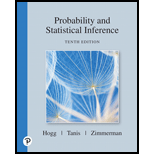
Concept explainers
Let X and Y be random variables of the continuo us type having the joint
Draw a graph that illustrates the domain of this pdf.
(a) Find the marginal pdfs of X and Y.
(b) Compute
(c) Determine the equation of the least squares regression line and draw it on your graph. Does the line make sense to you intuitively?
Want to see the full answer?
Check out a sample textbook solution
Chapter 4 Solutions
Pearson eText for Probability and Statistical Inference -- Instant Access (Pearson+)
- Question 3 [10 marks]. Suppose that X, Y and Z are statistically independent random variables, each of them with a x²(2) distribution. (a) Find the moment generating function of U = X + 3Y + Z. State clearly and justify all steps taken. (b) Calculate the expectation E(U) using the moment generating function.arrow_forwardCould you explain how to do part (c) pleasearrow_forwardLet X have a uniform distribution on (0,2) and let Y be independent of X with a uniform distribution over (0,3). Determine the cumulative distribution function of S=X+Y. Please can you help me solve this question. Also, could you explain how you know at which intervals to split up the cases of the fucntion.arrow_forward
- Could you please solve this question by sketching a graph to find the region of integration and the bounds of the integralarrow_forwardPlease could you provide a step by step solutions to this question and explain every step.arrow_forwardCould you please help me with question 2bii. If possible could you explain how you found the bounds of the integral by using a graph of the region of integration. Thanksarrow_forward
- Could you explain how the inequalities u in (0,1), we have 0 ≤ X ≤u-Y for any 0 ≤Y<u and u in (1,2), we either have 0 ≤ X ≤u-Y for any u - 1 < Y<1, or 0≤x≤1 for any 0 ≤Y≤u - 1 are obtained please. They're in the solutions but don't understand how they were derived.arrow_forwardCan you please explain how to find the bounds of the integrals for X and Y and also explain how to find the inequalites that satisfy X and Y. I've looked at the solutions but its not clear to me on how the inequalities and bounds of the integral were obtained. If possible could you explain how to find the bounds of the integrals by sketching a graph with the region of integration. Thanksarrow_forwardQUESTION 18 - 1 POINT Jessie is playing a dice game and bets $9 on her first roll. If a 10, 7, or 4 is rolled, she wins $9. This happens with a probability of . If an 8 or 2 is rolled, she loses her $9. This has a probability of J. If any other number is rolled, she does not win or lose, and the game continues. Find the expected value for Jessie on her first roll. Round to the nearest cent if necessary. Do not round until the final calculation. Provide your answer below:arrow_forward
- 5 of 5 (i) Let a discrete sample space be given by Ω = {ω1, 2, 3, 4}, Total marks 12 and let a probability measure P on be given by P(w1) 0.2, P(w2) = 0.2, P(w3) = 0.5, P(w4) = 0.1. = Consider the random variables X1, X2 → R defined by X₁(w3) = 1, X₁(4) = 1, X₁(w₁) = 1, X₁(w2) = 2, X2(w1) = 2, X2(w2) = 2, X2(W3) = 1, X2(w4) = 2. Find the joint distribution of X1, X2. (ii) [4 Marks] Let Y, Z be random variables on a probability space (N, F, P). Let the random vector (Y, Z) take on values in the set [0,1] × [0,2] and let the joint distribution of Y, Z on [0,1] × [0,2] be given by 1 dPy,z(y, z) (y²z + y²²) dy dz. Find the distribution Py of the random variable Y. [8 Marks]arrow_forwardTotal marks 16 5. Let (,,P) be a probability space and let X : → R be a random variable whose probability density function is given by f(x) = }}|x|e¯|×| for x Є R. (i) (ii) Find the characteristic function of the random variable X. [8 Marks] Using the result of (i), calculate the first two moments of the random variable X, i.e., E(X") for n = 1, 2. (iii) What is the variance of X? [6 Marks] [2 Marks]arrow_forwardTotal marks 16 5. Let (N,F,P) be a probability space and let X : N → R be a random variable such that the probability density function is given by f(x)=ex for x € R. (i) Find the characteristic function of the random variable X. [8 Marks] (ii) Using the result of (i), calculate the first two moments of the random variable X, i.e., E(X") for n = 1,2. (iii) What is the variance of X. [6 Marks] [2 Marks]arrow_forward
 Linear Algebra: A Modern IntroductionAlgebraISBN:9781285463247Author:David PoolePublisher:Cengage Learning
Linear Algebra: A Modern IntroductionAlgebraISBN:9781285463247Author:David PoolePublisher:Cengage Learning
